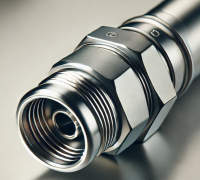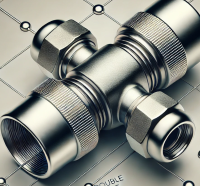Flare fittings play a crucial role in plumbing and mechanical systems, ensuring secure and leak-proof connections. These fittings are necessary for many industries, including hydraulics, refrigeration, and the automobile and aerospace sectors.
The various kinds of flare fittings, their uses, and how to pick the best one for your particular requirements will all be covered in this blog post.
What Are Flare Fittings?
Flare fittings are a type of pipe fitting that creates a leak-proof seal by flaring the end of a tube. This flaring process involves expanding the end of the tube outwards to form a cone shape. The flared end then mates with a mating nut and sleeve, creating a tight seal.
Flare fittings are typically made from materials like brass, steel, and stainless steel, chosen for their strength, corrosion resistance, and compatibility with various fluids.
Common Types of Flare Fittings
Several different types of flare fittings are available, each with its own unique characteristics and applications:
➡️ Single Flare Fittings:
These are the most common type, featuring a single flare on the end of the tube. They are relatively easy to install and are suitable for a wide range of applications.
➡️ Double Flare Fittings:
As the name suggests, these fittings feature two flares on the end of the tube. This design provides a more robust and leak-resistant seal, making them ideal for high-pressure systems.
➡️ Inverted Flare Fittings: Inverted flare fittings have a flare that is inverted or “inside out” compared to traditional flare fittings. This design offers a more compact and efficient connection.
➡️ Specialized Flare Fittings: These include industry-specific fittings like SAE flare fittings (used in automotive applications), JIC flare fittings (commonly used in hydraulic systems), and metric flare fittings (designed for international compatibility).
How to Choose the Right Flare Fitting for Your Needs
Selecting the appropriate flare fitting depends on several factors:
➡️ Pressure: The operating pressure of the system will determine the required strength and sealing capabilities of the fitting.
➡️ Material: Choose a material that is compatible with the fluid being transported and the operating environment (e.g., corrosion resistance).
➡️ Application: Consider the specific industry and application, as different types of fittings are better suited for certain tasks.
Installation and Maintenance of Flare Fittings
Proper installation of flare fittings is crucial for ensuring a leak-free and long-lasting connection. This typically involves using specialized flaring tools to create the desired flare on the tube.
Regular maintenance of flare fittings includes inspecting for signs of wear and tear, such as cracks, leaks, or corrosion. Tightening loose fittings and replacing damaged components can help prevent issues and extend the life of the system.
Conclusion
Choosing the right type of flare fitting is essential for the successful operation of any plumbing or mechanical system. By carefully considering factors like pressure, material, and application, you can select the most suitable fittings for your specific needs.
Proper installation and regular maintenance are also critical for ensuring the long-term reliability and safety of flare fittings. By following these guidelines, you can leverage the benefits of flare fittings to create secure, leak-proof, and efficient connections in your projects.
Post time: Jan-15-2025



